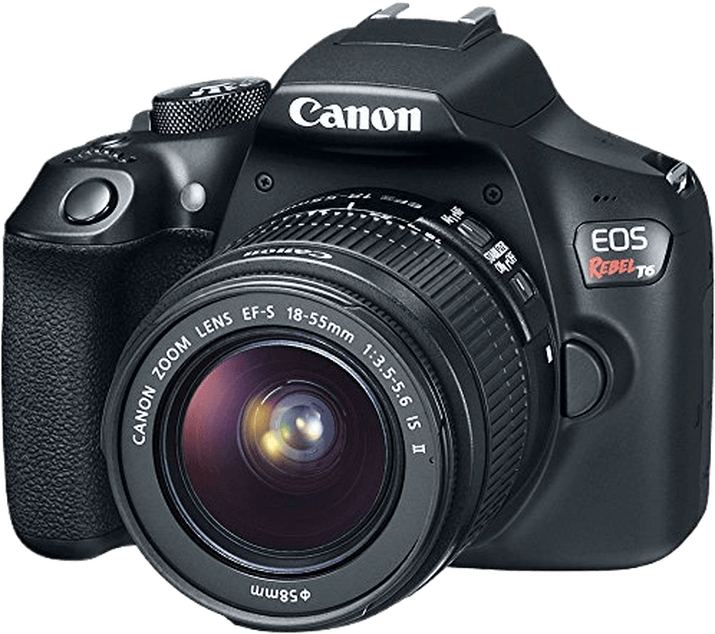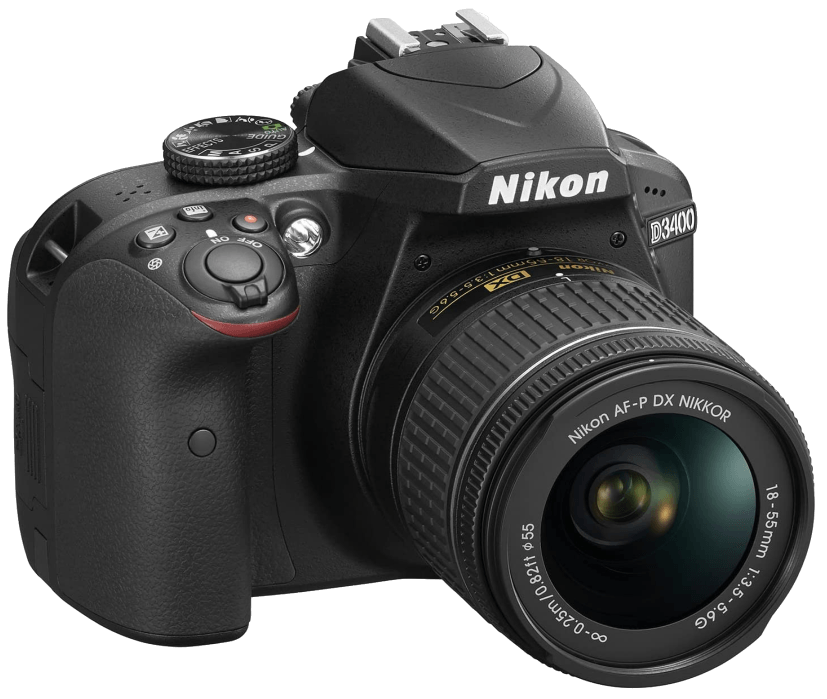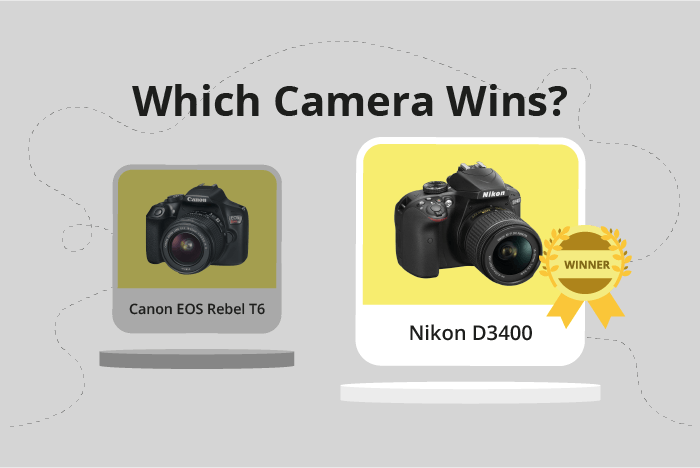Canon EOS Rebel T6 / 1300D vs Nikon D3400 Comparison
Canon EOS Rebel T6 / 1300D

Nikon D3400

The Nikon D3400 outperforms the Canon EOS Rebel T6 / 1300D with a score of 61/100 compared to the Canon’s 39/100. Both cameras are DSLR models released in 2016, with the Canon priced at $550 and the Nikon at $650. They share similar sizes, with the Canon measuring 129 x 101 x 78mm and the Nikon at 124 x 98 x 76mm.
The Nikon D3400 excels due to its higher score, making it a better camera. However, the Canon EOS Rebel T6 / 1300D has an advantage in terms of weight, being lighter at 485g / 1.07lbs compared to the Nikon’s 445g / 0.98lbs.
Taking these points into consideration, the Nikon D3400 is a superior choice for those seeking a higher-performing camera, while the Canon EOS Rebel T6 / 1300D may be more suitable for those prioritizing a lightweight option.
Canon EOS Rebel T6 / 1300D vs Nikon D3400 Overview and Optics
The Nikon D3400 emerges as the winner in the optics comparison with a score of 65/100, while the Canon EOS Rebel T6 / 1300D trails behind with a score of 40/100. Both cameras share some common specifications, such as an APS-C sized CMOS sensor, no image stabilization, and similar lens mounts – the Canon EF-S for the Rebel T6 and Nikon F DX for the D3400.
The Nikon D3400 outperforms the Canon Rebel T6 in several key aspects. With 24.2 megapixels, the D3400 captures more detail than the Rebel T6’s 18 megapixels. The D3400 also boasts a faster shooting speed of 5 frames per second, compared to the T6’s 3 frames per second. Additionally, the D3400’s Expeed 4 processor and higher DXOMARK sensor score of 86 contribute to its superior image quality, as opposed to the Rebel T6’s Digic 4+ processor and DXOMARK sensor score of 66.
Despite its lower overall score, the Canon Rebel T6 has some advantages over the Nikon D3400. Its Canon EF-S lens mount provides a wider range of lens compatibility, offering users more options to choose from.
Taking all factors into account, the Nikon D3400 clearly outshines the Canon EOS Rebel T6 / 1300D in terms of optics performance. Its higher megapixel count, faster shooting speed, and better processor make it the superior choice for capturing high-quality images. However, the Canon Rebel T6 still holds value for those who prioritize lens compatibility and the wider Canon lens ecosystem.
Canon EOS Rebel T6 / 1300D vs Nikon D3400 Video Performance
The Nikon D3400 outperforms the Canon EOS Rebel T6 / 1300D in video capabilities, with a score of 56 to the Canon’s 43. Both cameras share several specifications, such as Full HD max video resolution and dimensions of 1920 x 1080. Additionally, neither camera has built-in time-lapse functionality.
The Nikon D3400’s higher score comes from its ability to capture video at a maximum frame rate of 60fps, compared to the Canon T6’s 30fps. This allows the Nikon to produce smoother and more detailed video footage, particularly when capturing fast-moving subjects or scenes. This advantage makes the Nikon D3400 a better choice for users who prioritize video quality and performance.
On the other hand, the Canon T6 does not offer any specific advantages over the Nikon D3400 in terms of video capabilities. Its lower score reflects that it falls short in comparison to the Nikon, particularly in the frame rate aspect. This may not be a significant issue for users who primarily focus on still photography, but for those who value video performance, the Nikon D3400 is the clear winner.
In comparing the video capabilities of these two cameras, the Nikon D3400 emerges as the superior choice due to its higher frame rate. While both cameras share similar specifications in other aspects, the Nikon’s performance in capturing smoother and more detailed video gives it a definitive edge over the Canon EOS Rebel T6 / 1300D.
Canon EOS Rebel T6 / 1300D vs Nikon D3400 Features and Benefits
The Nikon D3400 emerges as the winner in the features comparison, scoring 54/100, while the Canon EOS Rebel T6 / 1300D scores 41/100. Both cameras share some common specifications, such as a 3-inch screen size and lack of a touchscreen. Neither camera has GPS capabilities.
The Nikon D3400 outperforms the Canon EOS Rebel T6 / 1300D in certain aspects. With a screen resolution of 921,000 dots, the D3400 offers a slightly higher resolution than the Rebel T6 / 1300D, which has 920,000 dots. Additionally, the D3400 features Bluetooth connectivity, enabling users to transfer images and control the camera remotely.
On the other hand, the Canon EOS Rebel T6 / 1300D has a flip screen, providing more flexibility when composing shots from different angles. This feature is not available in the Nikon D3400. Moreover, the Rebel T6 / 1300D has built-in Wi-Fi, allowing for easy sharing and transferring of photos. The D3400 lacks this feature but compensates with its Bluetooth connectivity.
In conclusion, the Nikon D3400 has a higher feature score and offers a marginally better screen resolution along with Bluetooth capabilities. The Canon EOS Rebel T6 / 1300D, although scoring lower, provides a flip screen and Wi-Fi functionality. Ultimately, the choice between these two cameras depends on the photographer’s preference for specific features and their intended use.
Canon EOS Rebel T6 / 1300D vs Nikon D3400 Storage and Battery
The Nikon D3400 outperforms the Canon EOS Rebel T6 / 1300D in storage and battery, scoring 45/100 compared to the Canon’s 27/100. Both cameras have one memory card slot and accept SD, SDHC, and SDXC cards. Neither camera supports USB charging.
The Nikon D3400’s advantage lies in its superior battery life, providing 1200 shots per charge with its EN-EL14a battery. On the other hand, the Canon EOS Rebel T6 / 1300D offers 500 shots per charge using its LP-E10 battery. This significant difference in battery life makes the Nikon D3400 a more reliable choice for extended shooting sessions.
However, the Canon EOS Rebel T6 / 1300D does not have any distinct advantages in storage and battery when compared to the Nikon D3400.
Considering the storage and battery aspects, the Nikon D3400 is the clear winner due to its longer battery life, making it a better choice for photographers who require extended shooting capacity.
Alternatives to the Canon EOS Rebel T6 / 1300D and Nikon D3400
Are you still undecided about which camera is right for you? Have a look at these popular comparisons that feature the Canon EOS Rebel T6 / 1300D or the Nikon D3400:

